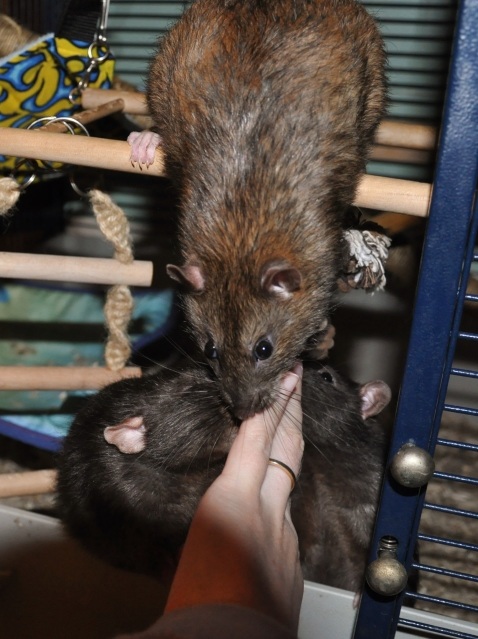Patience Method
What is it: This approach aims at slowly building trust with rats and allowing them to make the first move.
Why: This method works on the principle that by allowing the rat to take the first steps you gradually build a relationship that is very much trust filled and mutual.
Strengths: This can work particularly well with rats who are nervous or shy or those who freeze regularly under the Confidence method.
Weaknesses: This doesn’t work particularly well with rats who aren’t curious about humans (so may never make the first move). It can also backfire in situations where you have particularly dominant rats who can then see you as a push over and may become problematic in later life.
Hints and Tips: A rat bag or hoody with nice large front pocket can be useful for this. Put the rats in and spend time with your hand resting with them. Going out for trips to different and scary smelling locations can be used to encourage scared rats to see you as a safe retreat and so bond better In extreme cases starting out with something along the lines of T Touch can work well to familiarise a particularly scared or defensive animal with the idea and benefits of being touched
Why: This method works on the principle that by allowing the rat to take the first steps you gradually build a relationship that is very much trust filled and mutual.
Strengths: This can work particularly well with rats who are nervous or shy or those who freeze regularly under the Confidence method.
Weaknesses: This doesn’t work particularly well with rats who aren’t curious about humans (so may never make the first move). It can also backfire in situations where you have particularly dominant rats who can then see you as a push over and may become problematic in later life.
Hints and Tips: A rat bag or hoody with nice large front pocket can be useful for this. Put the rats in and spend time with your hand resting with them. Going out for trips to different and scary smelling locations can be used to encourage scared rats to see you as a safe retreat and so bond better In extreme cases starting out with something along the lines of T Touch can work well to familiarise a particularly scared or defensive animal with the idea and benefits of being touched
How to use this
- Once they have settled into the cage you offer your hand to them, let them sniff it on their own terms, this can sometimes mean getting comfy with your arm draped into the cage and spending some time like this. Eventually the rat will approach, sniff nervously then leg it.
- Keeping this up for a while will often lead to the rat increasing in confidence as it realises you are not going to hurt it.
- You can speed up this approach by offering food stuffs on your hand or a spoon (depending on how keen the rats are to use their teeth). Soft foods like cottage cheese or yoghurt work well as they can’t be taken and run off with, they need to be licked off. In some more extreme cases a rat will be too nervous even for this to work and it may be necessary to just spend time talking to them softly, but otherwise not approaching them until they seem ready.
- Once a rat responds to this approach move to encouraging them to move out onto your hand, bringing them close to your body when they do to help them feel secure but leaving an escape route back to the cage if they want. This works particularly well if you can position the cage next to a rat safe area like a sofa and spend time encouraging them to come out. With some rats this can take days, with others minutes. If you can’t do this then tempt the rat into a tube or cube bed and carry them to a rat safe area for interim free range
